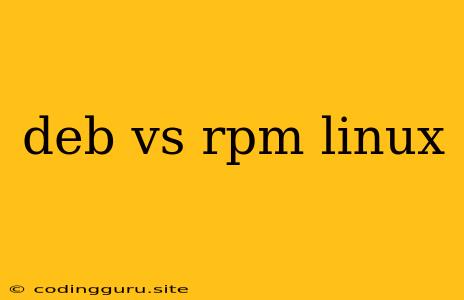The Great Debate: DEB vs. RPM in the Linux Ecosystem
Choosing the right package manager for your Linux distribution can feel like navigating a complex labyrinth. Two prominent players dominate the field: DEB and RPM. Understanding their differences is crucial for selecting the best package management system for your specific needs.
DEB and RPM represent two distinct package management philosophies. While both aim to streamline software installation and updates, they employ different formats and approaches, impacting how software is packaged, managed, and deployed.
What is DEB?
DEB is the file format used by the Debian package management system. It's the cornerstone of popular distributions like Ubuntu, Linux Mint, and elementary OS.
DEB packages adhere to a standardized format, containing not only the software itself but also essential metadata. This metadata includes dependencies, version information, and installation instructions, ensuring smooth installation and compatibility across different software packages.
What is RPM?
RPM stands for Red Hat Package Manager, and it's the native package management system for Red Hat Enterprise Linux (RHEL) and its derivatives, including CentOS, Fedora, and Oracle Linux.
Like DEB, RPM packages encompass the software along with metadata. This metadata facilitates dependency tracking, version control, and seamless updates, contributing to a robust and reliable package management experience.
DEB vs. RPM: Key Differences
1. Package Format: DEB and RPM differ significantly in their package file format. DEB packages typically use a .deb extension, whereas RPM packages end with a .rpm extension. These format variations stem from the distinct package management philosophies of Debian and Red Hat.
2. Package Structure: DEB packages often rely on a hierarchical structure within their archive, using directories and files to organize package components. RPM packages tend to use a more centralized approach, typically housing most of the package content within a single archive file.
3. Dependency Management: Both systems excel in dependency tracking, ensuring that software packages are installed with all their necessary components. However, they employ slightly different mechanisms for dependency resolution, leading to potential differences in handling complex dependencies.
4. Command-Line Tools: Both DEB and RPM offer command-line tools for package management. DEB uses dpkg and apt, while RPM uses rpm and yum (or dnf). While the commands may differ, they generally perform similar tasks, such as installing, removing, and updating packages.
5. Distribution Compatibility: DEB and RPM are generally confined to their respective distribution families. Software packages built for DEB-based systems won't seamlessly work on RPM-based systems, and vice versa. However, efforts exist to bridge this gap with tools like Alien.
6. User Experience: The overall user experience with both DEB and RPM is often considered positive. Both systems offer a consistent and intuitive approach to package management. However, preferences might vary based on factors like command-line familiarity, preferred software repositories, and distribution choice.
Choosing the Right Package Manager:
So, how do you decide which package manager is right for you? It comes down to your distribution and personal preference.
- If you're using a Debian-based distribution like Ubuntu, Mint, or elementary OS, you'll be working with DEB.
- If you're using a Red Hat-based distribution like CentOS, Fedora, or Oracle Linux, you'll be using RPM.
If you're switching between distributions or looking for specific software packages, tools like Alien can convert packages between DEB and RPM formats, potentially allowing for wider compatibility.
Examples
DEB:
- Installation:
sudo apt-get install <package_name> - Removal:
sudo apt-get remove <package_name> - Update:
sudo apt-get update && sudo apt-get upgrade
RPM:
- Installation:
sudo yum install <package_name> - Removal:
sudo yum remove <package_name> - Update:
sudo yum update
Tips for Package Management:
1. Use Official Repositories: Always prioritize official software repositories from your distribution for maximum security and stability.
2. Update Regularly: Regularly update your system and software packages to ensure the latest security patches and bug fixes.
3. Be Aware of Dependencies: Pay close attention to package dependencies and install any required components.
4. Use Package Managers Wisely: For more complex software installations, consider package managers like Snap or Flatpak, which offer containerized environments.
5. Experiment and Explore: Don't hesitate to explore different tools and approaches to package management. Finding what works best for your workflow is key.
Conclusion:
The battle between DEB and RPM is not a competition but a reflection of the diverse landscape of Linux distributions. Both systems offer reliable and efficient package management, catering to different distribution communities and user preferences. Understanding their unique characteristics allows you to make informed decisions for your Linux environment.
